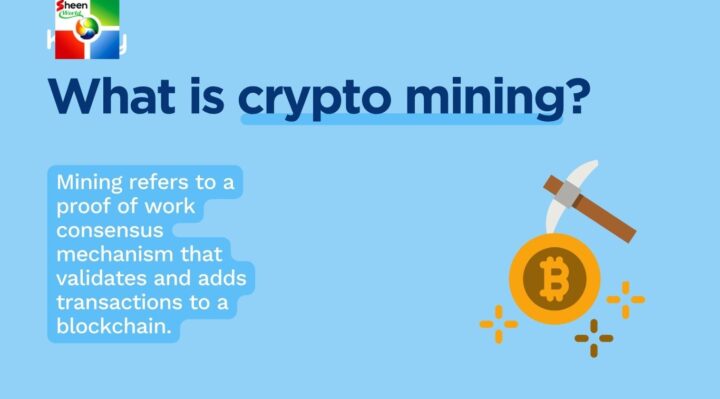
As cryptocurrencies continue to gain traction in the financial world, one term that frequently surfaces in discussions is crypto mining. But what exactly is crypto mining? This comprehensive guide will delve into the intricacies of crypto mining, exploring its mechanisms, significance, types, and the future implications for the cryptocurrency ecosystem. Whether you’re a novice looking to understand the basics or a seasoned investor seeking deeper insights, this article provides everything you need to know about crypto mining.
H1: Understanding Crypto Mining
H2: Definition of Crypto Mining
Crypto mining refers to the process of validating and adding transactions to a blockchain ledger by solving complex mathematical problems. Miners use powerful computers to compete in solving these problems, and the first one to find the correct solution gets to add the next block to the blockchain. In return for their efforts, miners are rewarded with newly minted cryptocurrency coins and transaction fees.
H3: The Role of Miners in the Blockchain Network
Miners play a crucial role in maintaining the integrity and security of the blockchain network. By validating transactions and ensuring that all participants adhere to the protocol rules, miners help prevent fraudulent activities and double-spending, thereby fostering trust in the cryptocurrency ecosystem.
H4: The Historical Context of Crypto Mining
Crypto mining first gained prominence with the launch of Bitcoin in 2009. The process was relatively simple at that time, requiring minimal computational power. However, as more miners entered the market and the difficulty of mining increased, the landscape evolved significantly, leading to the sophisticated mining operations we see today.
H1: How Crypto Mining Works
H2: The Basics of Blockchain Technology
To understand what crypto mining is, it’s essential to grasp the underlying technology: blockchain. A blockchain is a decentralized and distributed ledger that records all transactions across a network of computers. Each block contains transaction data, a timestamp, and a cryptographic hash of the previous block, creating a secure chain of information.
H3: The Mining Process
- Transaction Verification: When a user initiates a transaction, it is broadcasted to the network. Miners collect these transactions and verify their authenticity.
- Forming a Block: Verified transactions are grouped together to form a new block. Each block has a unique header that includes the hash of the previous block.
- Solving the Cryptographic Puzzle: Miners compete to solve a cryptographic puzzle, which involves finding a hash that meets certain criteria (e.g., a specific number of leading zeros). This process is known as Proof of Work (PoW).
- Adding the Block to the Blockchain: The first miner to solve the puzzle broadcasts the new block to the network. Other miners verify the solution, and once confirmed, the block is added to the blockchain.
- Receiving Rewards: The successful miner receives a block reward, which consists of newly minted coins and transaction fees from the transactions included in the block.
H4: The Importance of Hash Functions
Hash functions are critical in the mining process. They take input data and produce a fixed-size string of characters, which appears random. In the context of mining, hash functions ensure that even a small change in the input data results in a completely different hash, making it nearly impossible to alter transaction data without being detected.
H1: Types of Crypto Mining
H2: Proof of Work (PoW)
Proof of Work is the original consensus mechanism used in Bitcoin and many other cryptocurrencies. It requires miners to solve complex mathematical problems to validate transactions. PoW is energy-intensive and requires significant computational power, making it less environmentally friendly.
H3: Advantages of PoW
- Security: PoW provides a high level of security, as altering any part of the blockchain would require an immense amount of computational power.
- Decentralization: PoW promotes decentralization, as anyone with the right hardware can participate in mining.
H4: Disadvantages of PoW
- Energy Consumption: PoW mining consumes a significant amount of electricity, raising concerns about its environmental impact.
- Centralization Risks: As mining becomes more competitive, it can lead to centralization, with a few large mining pools dominating the network.
H2: Proof of Stake (PoS)
Proof of Stake is an alternative consensus mechanism that requires validators to hold a certain amount of cryptocurrency to participate in the block validation process. Instead of solving complex puzzles, validators are chosen based on the amount of cryptocurrency they hold and are willing to “stake.”
H3: Advantages of PoS
- Energy Efficiency: PoS consumes significantly less energy compared to PoW, as it does not require extensive computational power.
- Reduced Centralization: PoS can help reduce centralization, as it allows more participants to validate transactions without needing expensive hardware.
H4: Disadvantages of PoS
- Wealth Concentration: PoS can lead to wealth concentration, as those with more coins have a higher chance of being selected as validators.
- Security Concerns: PoS is relatively new, and its security implications are still being studied.
H2: Other Mining Methods
- Cloud Mining: This method allows users to rent mining power from remote data centers. It reduces the need for hardware investment but may come with risks related to the service provider.
- GPU Mining: Graphics Processing Units (GPUs) are popular for mining various cryptocurrencies due to their efficiency in handling complex calculations.
- ASIC Mining: Application-Specific Integrated Circuits (ASICs) are specialized hardware designed specifically for mining. They offer higher hash rates but can be costly.
H1: The Economics of Crypto Mining
H2: Costs Involved in Mining
- Hardware Costs: The initial investment in mining hardware can be substantial, especially for ASIC miners.
- Electricity Costs: Mining consumes a significant amount of electricity, and miners must factor this into their profitability calculations.
- Cooling and Maintenance: Mining rigs generate heat, requiring cooling solutions to prevent overheating and maintain efficiency.
H3: Profitability Calculations
To determine the profitability of crypto mining, miners must consider:
- Hash Rate: The speed at which a miner can solve cryptographic puzzles. Higher hash rates generally lead to better chances of earning rewards.
- Difficulty Level: The network’s difficulty level adjusts based on the total hash rate of the network. As more miners join, the difficulty increases, impacting profitability.
- Market Price: The current market price of the mined cryptocurrency directly affects profitability. Miners need to stay informed about market trends.
H4: Mining Pools
Many miners join mining pools to combine their computational power and increase their chances of earning rewards. In a mining pool, participants share their resources and split the rewards based on their contributions. This method can provide a more stable income stream compared to solo mining.
H1: Environmental Concerns and Sustainability
H2: The Environmental Impact of Crypto Mining
The energy consumption associated with crypto mining has raised significant environmental concerns. Critics argue that the carbon footprint of mining operations is unsustainable, particularly in regions where electricity is generated from fossil fuels.
H3: Sustainable Alternatives
- Renewable Energy: Some mining operations are transitioning to renewable energy sources, such as solar or wind power, to reduce their environmental impact.
- Energy Efficiency Improvements: Advances in mining hardware and technology aim to improve energy efficiency, making mining more sustainable.
H4: The Role of Regulation
Governments and regulatory bodies are increasingly scrutinizing crypto mining activities due to environmental concerns. Some countries have implemented regulations to limit energy consumption or encourage the use of renewable energy sources.
H1: Future of Crypto Mining
H2: Trends in Crypto Mining
- Shift to Proof of Stake: As the cryptocurrency landscape evolves, more projects are adopting PoS and other energy-efficient consensus mechanisms.
- Increased Centralization: The trend towards larger mining pools and operations could lead to increased centralization, raising concerns about network security.
H3: Technological Innovations
- Next-Generation Mining Hardware: Ongoing advancements in mining hardware aim to increase efficiency and reduce energy consumption.
- Decentralized Mining Solutions: New approaches to mining, such as decentralized mining pools, are being developed to promote fairness and inclusivity.
H4: The Impact of Institutional Adoption
As institutional investors enter the cryptocurrency space, their influence on mining operations and overall market dynamics will likely increase. This could lead to more sustainable practices and regulatory clarity.
H1: Conclusion
In summary, what is crypto mining is a multifaceted topic that encompasses the processes, technologies, and economic considerations associated with validating and securing transactions on blockchain networks. As the cryptocurrency landscape continues to evolve, understanding the intricacies of crypto mining will be crucial for anyone looking to participate in this exciting and dynamic field.
Whether you are an aspiring miner, an investor, or simply curious about the technology, this comprehensive guide provides a solid foundation for understanding crypto mining and its role in the broader cryptocurrency ecosystem. As advancements in technology and shifts in adoption continue to shape the industry, staying informed will be key to navigating the future of crypto mining.
This extensive guide covers the complexities of what crypto mining is, including its definition, mechanisms, types, and future implications. Whether you’re a beginner or someone looking to deepen your understanding, this article aims to equip you with the knowledge necessary to engage with the world of cryptocurrency mining effectively.



